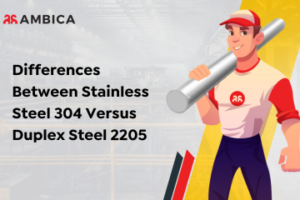 Introduction
Introduction
An alloy of Iron containing more than 10.5 % of chromium is classified as stainless steel. Alloying elements such as nickel, molybdenum, titanium, niobium and others are added based on properties desired. Stainless steels are classified into 5 types namely- Austenitic, Ferritic, Martensitic, Duplex and Precipitation Hardened. The classification is based on the microstructures present at room temperature.
Austenitic stainless steel is the most widely used of all the types. It is easy of fabricate, highly durable, has excellent strength retention at cryogenic and higher temperatures. This grade has the most diverse range of applications from architectural structures to extensive use in household equipment manufacturing. Few applications include- heat exchangers, Kitchen sinks and Cutlery, food and beverage equipment manufacturing.
Martensitic stainless steels can be hardened by heat-treatment unlike Austenitic and ferritic stainless steels which are strain hardened. Hardness depends on amount of carbon and heat treatment process followed. Higher hardness can be achieved which makes it ideal for manufacturing of tools. Some of the applications include surgical instruments, industrial blades, screw drivers, scissors.
Ferritic stainless steels contain chromium as the only principle alloying element other than iron. Applications of this grade are limited to thin gauges due to its welding constraint. Ferritic grades are used in vehicle exhaust systems, heat exchangers, home appliances manufacturing.
Duplex stainless steels have a two-phase micro-structure of austenitic and ferritic grades. It is twice as strong as its austenitic and ferritic counterparts. This grade is used in the most corrosive of environments like oil and gas industry, paper and pulp industry, chemical processing and storage.
Precipitation hardened stainless steels can be hardened by heat treatment. Additional alloying elements such as Copper, Aluminum are added to increase strength. It is mainly offered in solution annealed condition, which is readily machine-able. Post fabrication, a simple ageing process can help achieve desired mechanical properties with minimum to no distortion of shape. This makes use of PH- stainless steel ideal for defense and aerospace applications, where precision and accuracy are of utmost importance.
Basic properties of Stainless steels
1. Corrosion Resistance
The primary reason for use of stainless steels is their resistance to corrosion. Chromium present in the alloy tends to form a very thin passive layer of chromium oxide on surface of the metal. This inert film acts as a shield and prevents the underlying metal from corrosion. The film is self-repairing implying that it restores itself post any machining or defect, thus enhancing life of the metal.
2. Surface finish
Stainless steels are widely used in architectural and ornamental applications. Superior quality surface finish can be achieved which makes Stainless steel ideal for various decorative applications. It enhances aesthetic appearances without compromising on mechanical and structural rigidity. Many of the famous complex architectural structures now-a-days are being made out of stainless steel. Ease of formability into complex shapes coupled with superior aesthetics are major factors for rise in popularity of stainless steel in the infrastructure industry.
3. Ease of fabrication
Stainless steels are highly versatile when it comes to their applications. Austenitic series of stainless steels, which comprise of almost 80% of the stainless steel applications, is readily machine-able and does not require any specialized tools for fabrication. Alloying elements such as Sulphur and Phosphorous are used to produce free machining grades of stainless steel.
4. Composition based on Application
Based on desired applications, chemical composition of stainless steel can be altered. By carefully monitoring the alloying constituents during casting, customized compositions can be achieved. This is specifically useful for forging applications. For example- Companies may request for lower Sulphur and phosphorous composition in the final chemistry to prevent it from hot cracking during further processing.
5. Welding
Austenitic grades, which are the most widely used, are readily weld-able using all the conventional methods of welding. Specific details with respect to grades, choice of filler materials and welding conditions need to be followed during welding. No special skill sets are required for handling of stainless steels, thus making it welding friendly.
Conclusion
All the above properties make stainless steel an ideal choice for plethora of applications. Stainless steels require higher initial investment in comparison to other steels but if we consider the life cycle cost, it seems to be a prudent decision.
About Us
Ambica Steels Limited is one of the leading manufacturers of Stainless Steel in India. Our product range includes Precision Bright round bars, Square/Hexagonal/ Flat bars in HRAP and Cold drawn conditions. We also manufacture Billets and Ingots.
For any further information, please visit our Company website Ambica Steels or feel free to get in touch with us at info@ambicasteels.com.
About Author
Aniruddha Bauskar is responsible for New Business Development and Sales at Ambica Steels Limited. He likes reading and writing articles on various industries including Steel, Automobile and FMCG. You can find him on LinkedIn.”


